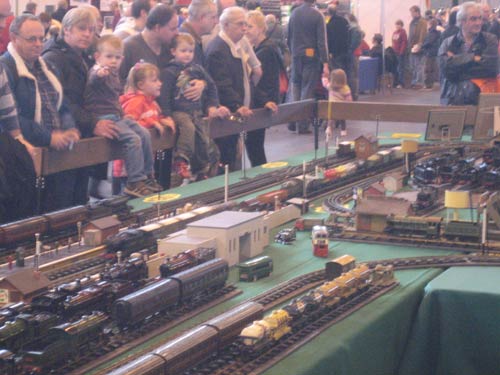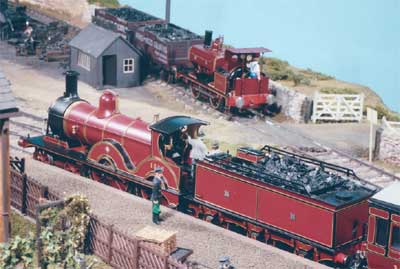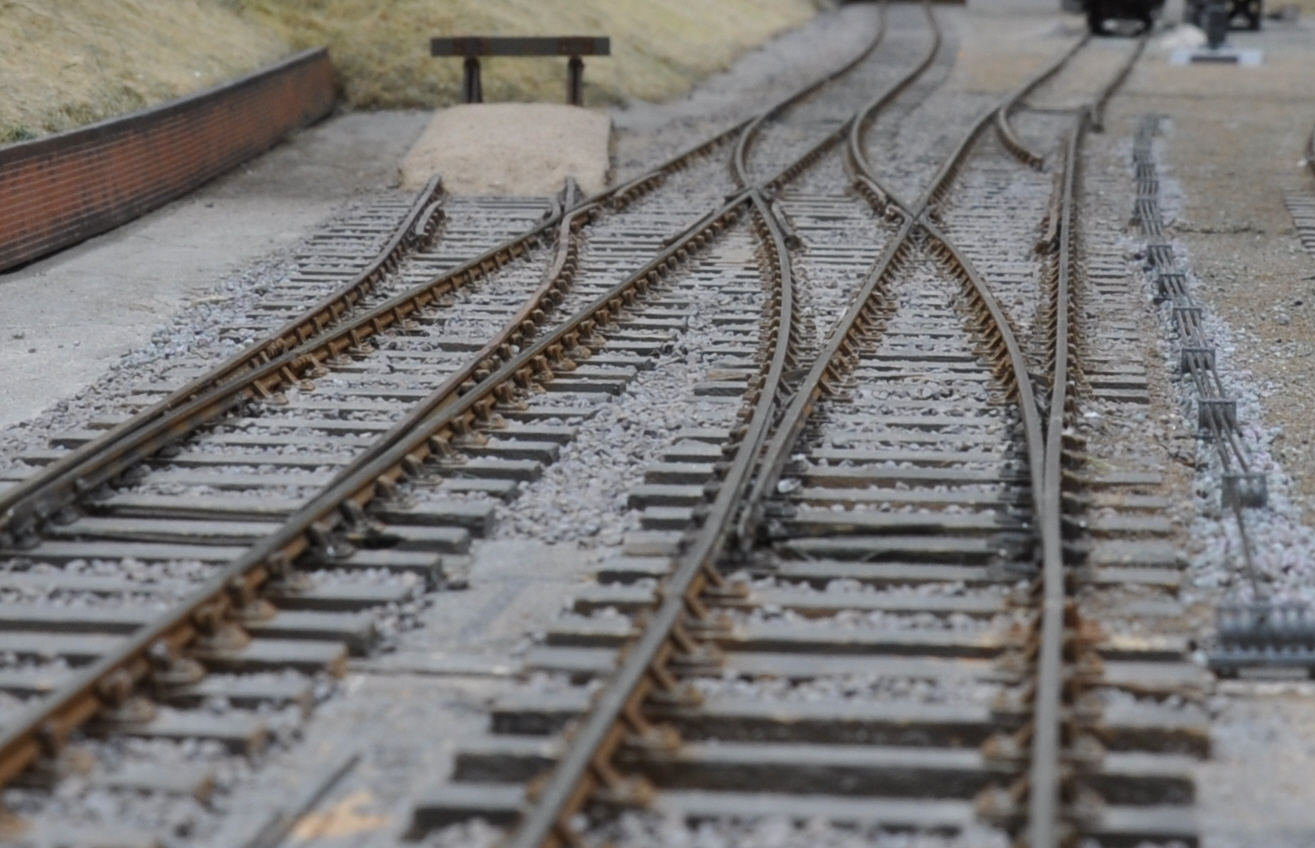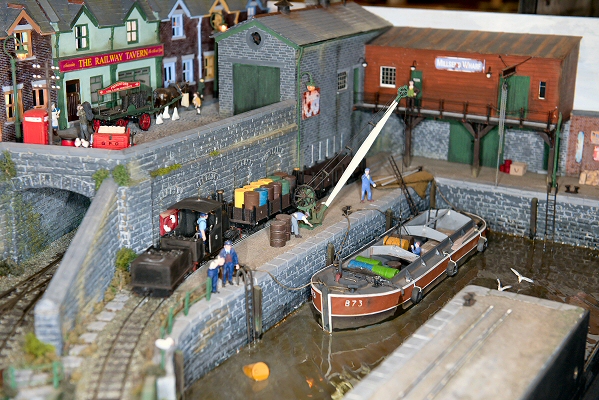What Is O Gauge?
Modelling in 7mm scale
There are many reasons why people make models of railways and railway
equipment and there is a large range of differing scales and gauges in
use. Almost since the beginning of the hobby 'O' gauge has been a popular
gauge to work in. Historically 'O' gauge referred to a track gauge of
1 1/4" or 32mm but is now almost universally taken to mean models
built to a scale of 7mm to the foot or 1:43.54, usually rounded off to
1:43.5. Prototype can be of Standard, Broad or any of the narrow gauges
and all are catered for by the Gauge O Guild, the object of which, as
stated in the rules, is to advance railway
modelling in the scales and gauges associated with the designation O.
This introduction seeks to outline the main variants of track and wheelset
standards used by 7mm scale modellers at the present time and to help
the newcomer to choose the most appropriate for him or her to work in.
A scale of 1:43.5 makes models which are a good size and easily handled,
while it is relatively easy to apply and appreciate fine details. Locomotives
can be powered by electricity, either from the rails using a 2 rail system,
a third rail, overhead catenary or stud contact, or from rechargeable
batteries, or by other power sources such as clockwork, steam or even
miniature internal combustion engines. They can be controlled through
the track or by radio control. Wagons and carriages have a satisfying
weight which makes them behave in a very proto-typical fashion. Their
size also makes taking them on to an outdoor railway a pleasant way of
enjoying gardening.
Technical Committee
There are a number of standards that have become established in 7mm scale
railway modelling.
This page taken fron an article by Ian Middleditch, a former member of the Guild's technical
committee, explains the differences between these standards. It covers
Coarse Scale, Fine Scale, ScaleSeven, Broad Gauge and Narrow Gauge. An
additional paragraph has been added explaing the more recent 0-MF (medium
fine) variant of Fine Scale.
You can find more on narrow gauge modelling at the website of the 7mm
Narrow Gauge Association and the ScaleSeven
Group publishes a full set of standards on its website.
The article is taken from the Guild's ever expanding manual,
which is now published on line, and is available for members only.
New members to the Guild can purchase all the material issued to date,
on CD or in hard copy form. See the sales page
for more details.
Standard Gauge Models
Models of Standard Gauge prototypes are by far the most popular amongst
modellers and have been so since the earliest days of model railways when
models bore little resemblance to the prototype. The relatively simple
construction methods used in making these toys, the need to run them on
the floor round sharp curves, powered by steam, clockwork, or electricity,
usually at totally unrealistic speeds, led to the adoption of oversize
wheel and track dimensions with very deep wheel flanges and extra wide
treads, to make road holding as reliable as conditions would permit.
As modelmaking techniques and expectations developed track dimensions
became closer to true scale and today a growing number of modellers work
to exact scale dimensions. There are now recognised standards that will
meet the needs of anyone desiring to follow railway modelling at a number
of different levels. However modellers do not always adopt the latest
developments but decide to work with what is established and they feel
comfortable with. This is particularly so for existing layouts, as it
is often very costly in both time and money to change one's collection
of models and equipment to a different standard. Newcomers to 7mm scale
should appreciate this and carefully consider which standard best meets
their particular requirements and aspirations.
Today there are three distinct British track and wheelset standards
in regular use. It is important to realise, however, that all three are
based on the same scale, 7mm/ft, and that much of the equipment, components
and kits on the market can be assembled to comply with any of the standards.
In particular, rail sections are no longer associated with particular
track standards.
The standards apply only to the dimensions of track and wheelsets. They
are not related to the faithfulness of reproduction of a prototype nor
to the amount of detail incorporated in a model. There now follows a brief
description of each standard with an outline of its advantages and disadvantages.
Coarse Standard

Progress in railway modelling has tended to be dominated by developments
in track; its cost, availability and durability. The first draft of the
standard listed today in the Guild Manual as Coarse was published by the
British Railway Modelling Standards Bureau in 1941. Before that date,
apart from track gauge, there were no generally adopted standards in railway
modelling in the UK. The first standard, 'O Standard', was developed from
existing commercially available O gauge track and wheelsets. Since it
was readily available, vast quantities were produced and much is still
in existence. The track gauge used is 32mm. Few newcomers adopt the standard
but there are still a substantial number of devotees who continue to add
to their systems. Many club layouts and test tracks have crossings laid
to Coarse Standard, which permit use by the greatest variety of rolling
stock.
Advantages
- The deeper flange and wider tread ensures the wheels are more tolerant
of bad track.
- Track is compatible with most 32mm gauge wheelsets.
- Second-hand models tend to be priced towards
the bottom end of the market.
Disadvantages
- Trackwork crossing dimensions are overscale
with wide crossing gaps and point throws.
- Wheel back to back size is less than scale,
which may necessitate altered dimensions for
loco frames and some distortion of bodywork.
- Kits with inside frames may require modification
to accommodate Coarse Standard wheelsets.
Fine Standard (or Finescale)

This is by far the most commonly used standard to-day. Fine Standard,
commonly described incorrectly as fine scale, has been developed to give
a fair compromise between appearance and ease of use. Track gauge is 32mm
which brings the outer face of standard wheel sets to almost the scale
distance apart thus preserving appearance yet permitting overwidth wheels.
Advantages
- Fine Standard is the nearest to true scale
dimensions of any 32mm gauge standard
(including the American NMRA standard, etc.)
- As the standard leaves a greater than scale
clearance between the wheel flanges and the
rails, models will run round curves much
sharper than scale.
- Ready to run models through the trade are
almost always use fine standard wheelsets.
(Imported models will usually have Universal
wheelsets).
Disadvantages
- Wheel back to back size is less than scale,
which may necessitate altered dimensions for
loco frames and some distortion of bodywork.
- Crossing dimensions are over scale with increased clearances which some
modellers may consider gives a less than satisfactory appearance.
0-MF
0-MF, or Medium Fine, has developed as a way of ensuring that the track
on which Fine Scale stock runs is consistent with the standards that have
been adopted and are commonly used for Fine Scale wheels. This involves
ensuring that the check gauge (the distance between the outside of the
check rail to the inside face of the opposite running rail) is consistent
with the wheel back to back measurement. For Fine Scale stock this results
in a reduction in the track gauge from 32mm to 31.5mm. This gives the
better look of narrower flangeways through points and a shorter gap over
crossings which means that wheels do not "drop" into the crossing
gap giving the rolling stock an unsightly lurch. A number of significant
railways have in recent years been built to these dimensions.
Advantages
- Improved running
- Better look to pointwork
- Finescale rolling stock can be used
Disadvantages
- Pointwork must be hand built
- Slightly further under scale gauge than Finescale
Scale Seven

Developed from the prototype, Scaleseven uses exact scale crossing dimensions
and a gauge of 33mm.
Advantages
- Prototype drawings used for model construction
do not require modifications to accommodate
wheelsets.
- Trackwork can be an exact copy of the prototype.
Disadvantages
- Wheelsets and track are not compatible with
any of the 32mm gauge standards.
- Springing or compensation is often preferable but not essential
- Curves must be closer to prototype than other
standards.
Modelling other track gauges using 7mm scale
As well as standard gauge, 7 mm scale is also used to model railways
with other gauges. There are distinct advantages of using the scale due
to the wide availability of components and parts that can be used. The
increased bulk of models in 7mm scale allows models to be built and motorised
which would be beyond the skills of most modellers in smaller scales.
This applies in particular to diminutive prototypes; older prototypes
often with tiny boilers and spindly wheels can make exquisite subjects.
Broad Gauge
Modelling any of the broad gauge systems can be done using components
intended for the three standards outlined above. All wheel and trackdimensions
remain the same with the exception of those based on the track gauge which
must be increased to suit the chosen prototype. There are few commercial
items available specifically for the broad gauges.
Narrow Gauge

Modellers who follow the narrow gauges can be split into two broad categories.
Those who build their models onto existing commercially available track
systems, 00, EM, TT, N or Z Gauge which approximate to 2'3", 2'6",
1'6", 1'3" and 10 1/2" gauge and those who choose to model
the exact track gauge and build their own trackwork. Both options permit
the use of all the general components aimed at 7mm scale such as buildings,
figures, scenic details, etc. but there are other considerations, listed
below.
Illustration: Llandydef Station transfer siding, showing the comparison
in size between the Standard Gauge track in the foreground and the Narrow
Gauge siding. (Gordon Gravett)
Using commercial track